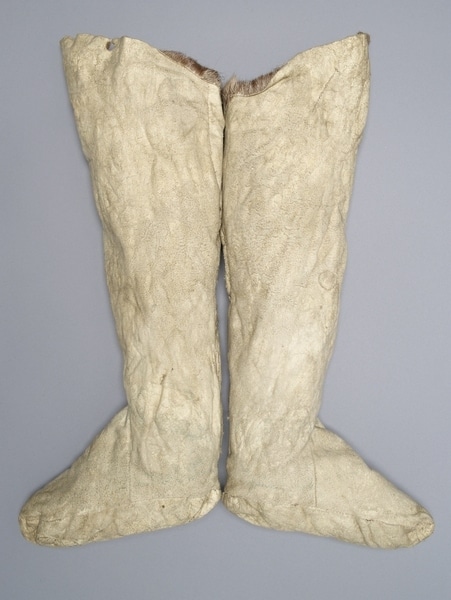Inner Boots Item Number: 565/1 a-b from the MOA: University of British Columbia


Description
Pair of inner stockings of caribou skin with the fur on the inside. The stockings reach to the knee and are higher in the front than in the back. The stockings consist of a piece of skin forming the sole, a vamp section and a large piece of skin that forms the leg section with a seam in the back of the leg.
History Of Use
Usually worn inside outer stockings and/or boots.
The insulating capability of animal skins is enhanced by the practice of wearing two layers of skin clothing, especially in winter. One layer of clothing is worn with the fur on the inside and a second layer is worn with the fur on the outside. The clothing also is designed so as to minimize ingress of wind and cold. During winter men and women wear two hooded waist-length coats, two pairs of trousers, two pairs of stockings and boots, and mittens. Men often wear a longer, heavier outer coat when outdoors in winter. While mass-produced clothing from the south is now commonly worn, the making of skin clothing is being revived in the Arctic.
In the Arctic, the making of clothing is considered as important as the creation of sacred objects. Aside from its important function as protection against the cold, clothing is imbued with power and spirituality. Women as seamstresses play an extremely important role in the expression of cultural value and meaning. The clothing of each group is cut and decorated according to distinctive cultural aesthetics. In addition to expressing the group’s identity, seamstresses express the beliefs and values of the group through clothing, which marks social identities like gender, age, childbearing status, and geographical origin. Clothing also expresses the special relationship of people in the Arctic with the animal world. People, animals, and spirits are subject to metamorphosis. Clothing often refers to this ability to transform, and could effect such a metamorphosis.
Specific Techniques
The pieces are sewn together with an overcast stitch.
Cultural Context
footwear
Narrative
Collected somewhere in the area of Great Slave Lake, but thought to originate from the Inuinnait.
Item History
- Made in Nunavut, Canada
- Collected before 1914
- Owned by T. P. O'Kelly
- Owned by Evelyn O'Neil before November 9, 1979
- Received from Evelyn O'Neil (Donor) on November 9, 1979
What
- Name
- Inner Boots
- Identification Number
- 565/1 a-b
- Type of Item
- boot
- Material
- caribou skin and caribou sinew
- Manufacturing Technique
- cut, pieced and sewn
- Part B
- height 60.0 cm, width 7.5 cm, depth 24.5 cm
- Part A
- height 59.0 cm, width 8.0 cm, depth 25.0 cm
Who
- Culture
- Inuit: Inuinnait
- Previous Owner
- T. P. O'Kelly and Evelyn O'Neil
- Received from
- Evelyn O'Neil (Donor)
Where
- Holding Institution
- MOA: University of British Columbia
- Made in
- Nunavut, Canada
When
- Collection Date
- before 1914
- Ownership Date
- before November 9, 1979
- Acquisition Date
- on November 9, 1979
Other
- Condition
- fair
- Accession Number
- 0565/0001 a-b